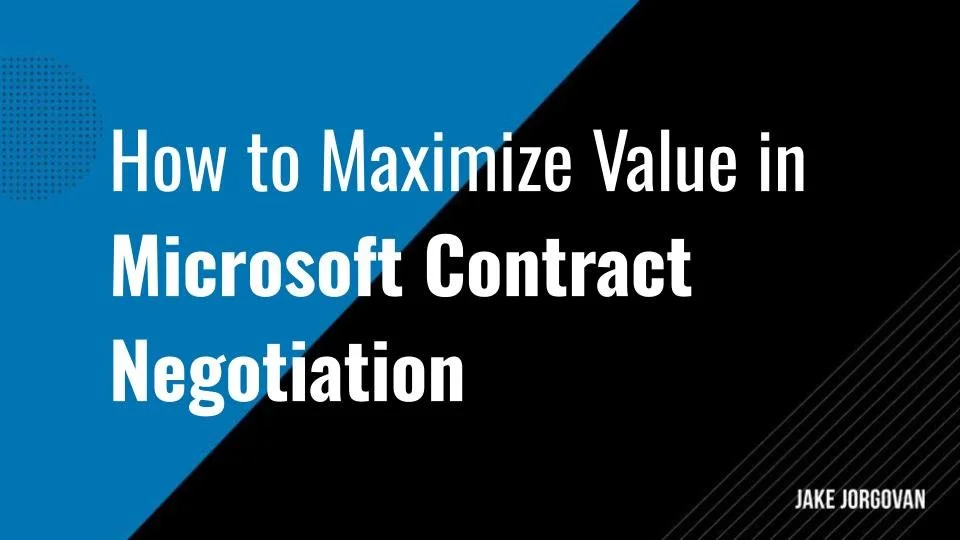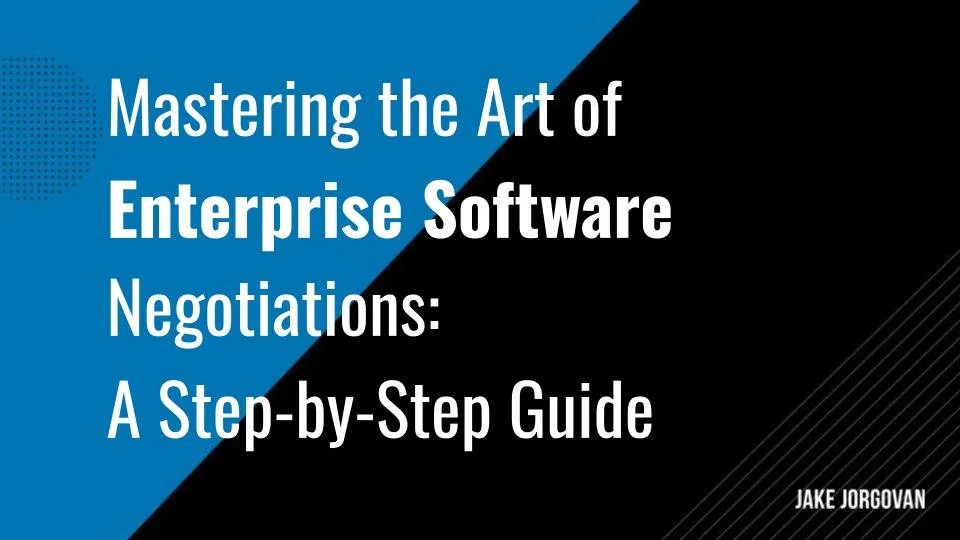Negotiating Software Contracts: A Guide for Business Leaders
Software contract negotiation requires meticulous attention to detail and strategic foresight.
The stakes are high, with financial resources and operational efficiency on the line. In fact, poor contract management practices can cost businesses up to 9% of their annual revenue.
If you're overwhelmed by software agreements' complexities, you're on the right page.
This guide will give you the knowledge and strategies needed to negotiate successfully.
Here’s what you’ll find inside:
The key components of software contracts
5 key steps when negotiating software contracts
How to effectively manage each step during the negotiation process
Stay with us as we dive into the essentials of negotiating software contracts, and we’ll make sure you get the best possible deal for your company.
Key Components of Software Contracts
Software contracts are legal agreements defining the terms of service, responsibilities, and expectations between clients and software providers. Whether you’re working with Oracle, Workday, Microsoft, Salesforce, SAP, or another vendor, these contracts ensure both parties are aligned on the deliverables, costs, and legal obligations.
Negotiating software contracts can have an enormous impact on the amount you ultimately end up paying, as well as the terms and conditions involved. For example, in one example by MetrixData360, a client was able to save more than $1 million after negotiating.
Here are some key elements that should be carefully considered and clearly defined in any software contract with vendors:
Scope of Services
This section details the specific services the vendor will provide, including software development, maintenance, support, and any other related services. It should clearly outline what is included in the contract and any services that might incur additional costs. Precision in defining the scope helps prevent misunderstandings and scope creep, ensuring the project stays on track and within budget.
Payment Terms and Conditions
This part specifies the pricing, payment schedules, and payment conditions. It may include upfront payments, milestone payments, and penalties for late payments. Clear payment terms are essential for financial planning and maintaining a positive working relationship between the client and the vendor.
Intellectual Property Rights
This clause addresses the ownership of the software, source code, and any related intellectual property (IP) created during the contract. It should define who holds the IP rights upon the project's completion and any licensing arrangements if the vendor retains ownership. Understanding and negotiating IP rights upfront can prevent legal disputes down the line.
Confidentiality and Data Protection
Given the sensitive nature of software projects, this element outlines how confidential information and personal data will be protected. It includes non-disclosure agreements (NDAs) and compliance with relevant data protection regulations (e.g., GDPR). Data security and privacy are critical in building trust and safeguarding proprietary and personal information.
Termination and Dispute Resolution
This final key element outlines the conditions under which either party can terminate the contract and the process for resolving disputes. Whether through mediation, arbitration, or litigation, having a clear dispute resolution mechanism can help manage conflicts efficiently and preserve professional relationships.
5 Key Steps for Effectively Negotiating Software Contracts
Incorporating the elements above into vendor software contracts ensures a comprehensive and clear agreement that mitigates risks and creates successful partnerships. Now, let’s look at the steps you can take to achieve that goal:
1) Identify and Prioritize Business Requirements
What do you actually need your chosen software to do? There are many potential things to consider here, as shown in the graphic below:
To effectively identify and prioritize your business requirements and objectives for negotiating software contract terms, follow these specific steps:
Define core business needs: List the core functionalities and capabilities the software must have to meet your business's operational needs. This should be based on a clear understanding of your business processes and how the software will improve or streamline these processes.
Consult stakeholders: Engage with key stakeholders across different departments (e.g., IT, finance, operations) to gather insights on what features, integrations, or support they require from the software. This step ensures the selected software meets cross-departmental needs and has wider buy-in. This is a crucial step for many reasons. For example, in the case of implementing procurement software, 71% of companies consider a clear definition of requirements as the key success factor.
Analyze current gaps: Review your current software solutions and identify functionality, usability, or support gaps. Understanding these gaps will help you pinpoint critical features your new software must have.
Set objectives for the software: Based on the needs and gaps identified, articulate clear objectives for what you aim to achieve with the new software. These could range from improving operational efficiency and improving customer experience to reducing costs.
Prioritize requirements: Not all requirements are equally important. Rank your list of needs and objectives by priority, distinguishing between 'must-haves' and 'nice-to-haves.' Consider factors such as impact on business operations, ROI, and urgency.
Consider future scalability: Consider how your business might grow or evolve in the coming years. Ensure that your requirements include scalability and flexibility to accommodate future changes.
Document your requirements: Finally, consolidate your findings into a comprehensive document. This document clearly outlines your prioritized business requirements and objectives. It will serve as a foundational reference throughout the negotiation process, helping to keep discussions focused and aligned with your business goals.
Following these steps will prepare you to enter negotiations with a clear understanding of your business's needs from a software contract, positioning you for more favorable terms and outcomes.
2) Conduct Thorough Market Research and Benchmarking
When conducting thorough market research and benchmarking in the context of software contracts, there are some concise and actionable steps you can follow.
Start by listing software tools that serve similar purposes within your industry. Include both direct competitors to your current solution and any emerging technologies. This broad view helps ensure you don’t miss innovative or more cost-effective options.
For each identified software solution, collect detailed information on pricing models, subscription terms, and any volume discounts. This data can often be found on vendor websites, through direct inquiries, or in industry reports.
Then, analyze each software solution's features and capabilities against the prioritized requirements you outlined earlier. Software comparison tools can be beneficial here; for example, Technology Evaluation Centers (TEC) offers a comprehensive database of features and functions within almost 1,000 business software solutions, aiding in side-by-side comparisons. This step involves matching your 'must-have' and 'nice-to-have' features with what each software offers, including any unique capabilities that could benefit your business.
Take a look at this graphic for some ideas of features to look for:
Be sure to research each software vendor's market reputation, focusing on customer service, reliability, and the quality of their support services. Online reviews, case studies, and testimonials can provide valuable insights into other customers' experiences.
It can help to engage with your professional network, including peers in similar roles or industries, to gain firsthand insights into their experiences with the software solutions you’re considering. Consulting with industry analysts can also provide a broader perspective on the software’s market position and performance.
For each software option, you should conduct a cost-benefit analysis that weighs the total cost of ownership (including any implementation and ongoing support costs) against the expected benefits, such as increased efficiency, productivity gains, or other ROI factors.
Finally, compile your research findings into a structured document or spreadsheet. This should include a comparative analysis of features, costs, benefits, and potential drawbacks, providing a clear overview to support informed decision-making in the negotiation process.
Grab this free template to make life easier:
| Criteria | Software Option 1 | Software Option 2 | Software Option 3 |
|---|---|---|---|
| Software Name | |||
| Features | |||
| Pricing Model | |||
| Subscription Terms | |||
| Volume Discounts | |||
| Market Reputation | |||
| Support Quality | |||
| Unique Capabilities | |||
| Implementation Costs | |||
| Ongoing Support Costs | |||
| Expected Benefits (e.g., ROI) | |||
| Potential Drawbacks | |||
| Overall Score/Rank |
3) Develop a Negotiation Strategy, Including Fallback Positions
The negotiation process can be long and complex. Just look at the graphic below for an idea of the many stages involved.
To develop a successful negotiation strategy for software contracts that aligns with your business needs, follow this targeted plan:
Set clear negotiation goals: Based on your business requirements and market research, define specific goals for the negotiation. These goals could include pricing discounts, favorable payment terms, customizations, or improved support levels. Make sure your goals are realistic, measurable, and aligned with your business objectives.
Understand the vendor's position: Research the vendor’s business model, including how they price their software and what terms they might typically negotiate on. Understanding the vendor’s priorities, such as securing long-term contracts or expanding their market share, can give you negotiation leverage.
Identify your leverage points: Assess the strengths of your position, such as the potential for a long-term partnership, the volume of licenses you need, or your willingness to serve as a reference customer. These factors can be leveraged to secure more favorable terms.
Determine your non-negotiables: From your list of requirements, identify which aspects you are unwilling to compromise on. These are your deal breakers and will guide you on when to stand firm in negotiations.
Prepare alternatives and fallback positions: Have an alternative or fallback position ready for each negotiation goal. Knowing your acceptable range of outcomes for each point will allow you to negotiate flexibly without compromising on critical needs.
Develop a communication plan: Decide on who will lead the contract negotiations from your team and establish clear communication guidelines. It's crucial to present a united front with predefined responses for likely vendor propositions or objections.
Practice scenarios: Run through mock negotiation scenarios with your team, practicing how you’ll articulate your needs, respond to counteroffers, and leverage your strengths. This preparation can improve your negotiation tactics and confidence.
Create a timeline: Establish a clear timeline for the negotiation process, including decision deadlines. This helps keep negotiations focused and can provide leverage if the vendor is eager to close the deal by a certain date.
Very few negotiators actually have a plan. In fact, research shows that 85% of sales negotiators don't establish what the other side wants upfront. Having a clear negotiation plan is a great opportunity to stand out and claim an advantage.
4) Engage in Transparent and Constructive Negotiations with Vendors
Engaging in transparent and constructive negotiations with software vendors is a nuanced process that demands a strategic approach but has been shown to have positive results for both parties.
To navigate this effectively, before negotiations begin, prepare a detailed brief for each vendor. This document should clearly outline your business requirements, priorities, budget constraints, and desired outcomes. It serves to set the stage for a focused discussion.
Next, arrange for initial meetings with each vendor. These meetings are an opportunity to present your requirements and to get a sense of the vendor's willingness to meet your needs. Be clear about your objectives but open to listening to their suggestions and solutions.
In your discussions, articulate why certain features or terms are essential for your business. Use data and examples from your market research to back up your requests. This will demonstrate that your demands are based on thorough analysis and are not arbitrary.
Invite vendors to propose solutions that meet your core requirements. This approach creates a collaborative atmosphere and can lead to innovative solutions that benefit both parties. It also allows vendors to highlight their strengths and unique offerings.
Remember to discuss terms beyond price. While price is important, don’t neglect other critical aspects of negotiations, such as service levels, support, scalability, and flexibility. These factors can significantly impact the value you receive from the software in the long run. In the graphic below, you can see a few examples of common SaaS contract terms.
Always aim for agreements that offer mutual benefits. Showing a willingness to work towards solutions that also advantage the vendor can lead to more favorable terms and a strong, long-term partnership.
As negotiations progress, document agreed-upon terms and any adjustments. This ensures both parties clearly understand the discussions and decisions, reducing the risk of future misunderstandings.
Before finalizing the contract, review the negotiated terms thoroughly to ensure they align with your initial objectives and requirements. If necessary, be prepared to go through another round of discussions to fine-tune the agreement.
5) Review and Fine-Tune Contract Details Before Finalizing
Reviewing and fine-tuning contract details before finalization leads you to a software agreement that aligns with your business needs. Here’s a structured approach to effectively handle this phase:
Compile contract documents: Gather all relevant documents, including the draft contract, any amendments agreed upon during negotiations, and supporting documents such as SLAs (Service Level Agreements), privacy policies, and security standards.
Conduct a detailed review: Begin with a comprehensive review of the contract. Pay close attention to key sections such as pricing and payment terms, termination clauses, renewal options, data ownership, confidentiality, liability limitations, and indemnification. Look out for any hidden costs. Ensure that all previously negotiated terms are accurately reflected.
Verify alignment with business requirements: Cross-reference the contract against your prioritized list of business requirements and objectives from Step 1. Confirm that the contract meets all 'must-have' criteria and as many 'nice-to-have' elements as possible without introducing unacceptable risks or costs.
“There is ample room for slip-ups during negotiation. The last thing you want is a legal dispute from unclear, vague, or inaccurate contract clauses.” — Cobblestone Software
Consult with legal and financial experts: Engage your legal team or an external legal advisor to scrutinize the contract for any legal loopholes or ambiguous language that could pose a risk. Similarly, have your finance team review cost-related clauses to ensure they align with your budget and financial planning.
Prepare a list of revisions: Compile a list of required revisions or clarifications based on the reviews. This list should clearly articulate the changes needed and the reasons behind them, prioritized by importance.
Negotiate final adjustments: Schedule a meeting or a call with the vendor to discuss your proposed revisions. Approach this as a collaborative effort to refine the contract, focusing on clarifications and adjustments that ensure mutual understanding and agreement.
Once all parties agree on the revisions, ensure these changes are incorporated into the final version. Conduct a final review to confirm that all adjustments are correctly reflected. After the final review, proceed to the formal execution of the contract. Ensure that all necessary parties sign the contract and that you obtain copies for your records.
Negotiating The Right Deal for You
This article discussed the essentials of negotiating software contracts, offering practical strategies and key considerations you can implement today. We've covered everything from understanding your needs to the importance of agreement flexibility and clarity.
To effectively negotiate software contracts, enter discussions with a clear understanding of your business requirements and remain open to negotiation on terms that benefit both parties. Keeping communication clear and ensuring the contract reflects mutual understanding and agreement will lead to more favorable outcomes for your company.
Also, remember that the right deal is not just about cost but also about securing software that aligns with your business goals and growth. Use these insights as a guide to confidently navigate your next negotiation so you can ensure the best possible terms for your business.
Frequently Asked Questions
How to negotiate with a SaaS vendor?
Research the vendor’s pricing models, understand your business needs, and identify alternatives. Approach the negotiation with a clear list of priorities, aiming for flexibility in terms of pricing, support, and scalability.
What are the main types of software contracts?
The main types include perpetual licenses, subscription-based agreements, and pay-as-you-go models. Each type differs in payment structure, usage terms, and flexibility.
What is the best approach when negotiating vendor contracts?
The best approach is to prepare thoroughly by analyzing your needs, benchmarking alternatives, and engaging all stakeholders. Focus on securing favorable terms for pricing, flexibility, and ongoing support.
What is the BATNA strategy?
BATNA (Best Alternative to a Negotiated Agreement) refers to the best outcome you can achieve if negotiations fail. Knowing your BATNA strengthens your position and ensures you don’t settle for unfavorable terms.
How to be a good contract negotiator?
A good contract negotiator is well-prepared, communicates clearly, and prioritizes key objectives. They also remain flexible and use data-driven arguments to secure fair and mutually beneficial terms.
How to negotiate vendor pricing?
Start by understanding the vendor’s pricing structure and market standards. Use leverage like alternative options or multi-year commitments to secure discounts, additional features, or more favorable terms.
































